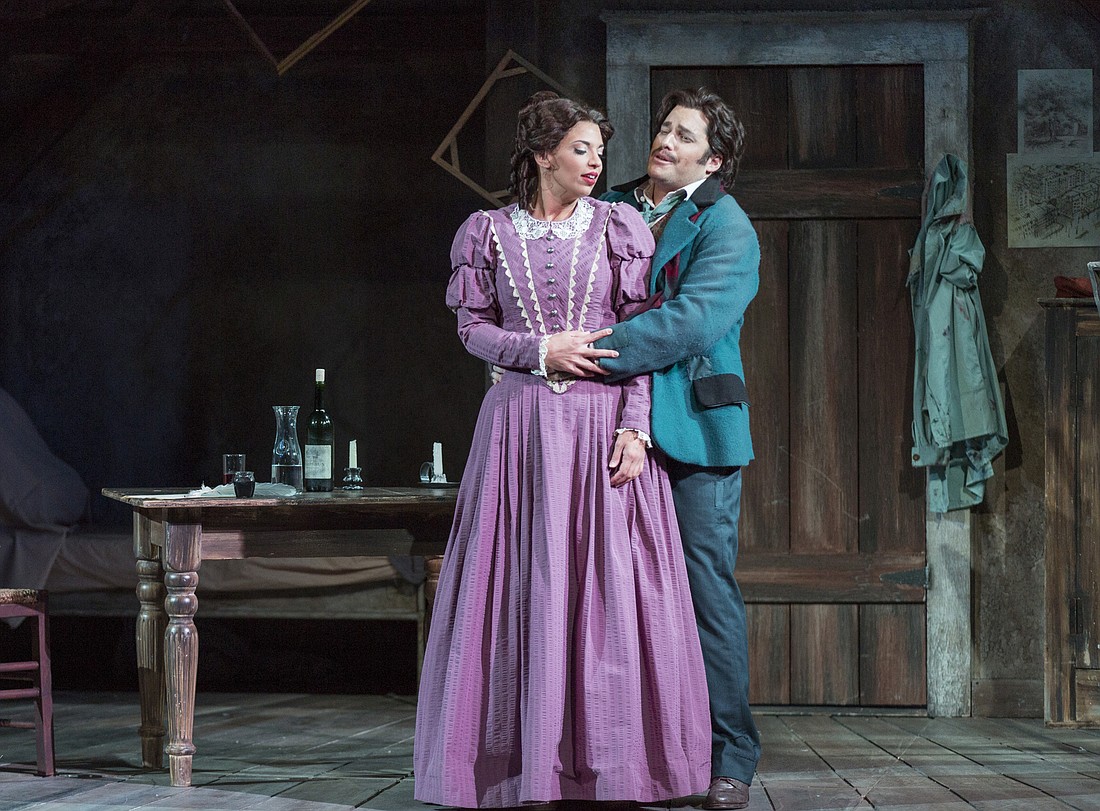- April 25, 2024
-
-
Loading

Loading

Sarasota Opera opened its fall season over the weekend with Puccini’s “La bohème,” but, because the essence was in the elements, this was a production that took the composer at his word and left a lasting impression. “La bohème” is probably one of the most popular operas. It’s the one we see most often, and it’s the one we take newbies to see so that they’ll come back for more.
Puccini, as we’ve said many times before, was a true man of the theater. He knew how to take real people and make us feel as if we’ve stepped into their lives. See it once, and you want to know more about the Bohemian quartet of artists in Paris and their lovers. See it over and over throughout your life time, and you watch each of them grow and become part of your family. No matter how many times you see it, in a good production, “La bohème” brings tears to your eyes because of its characters, its story and its myriad melodies that stay with you forever.
In the hands of stage director Stephanie Sundine, these old friends on stage grew larger than life. Little touches, like the muff Mimi asks for on her death bed, took on a new light as, with her last breath, she drops it on the floor and one of the Bohemians, Schaunard (a musician), not realizing she’s died, goes to tuck her hand inside it. As he does that simple movement, he realizes she’s dead and our onstage world collapses. A small touch, but a brilliant one that’s not often done.
It’s those little things that make Sundine’s direction special.
The first act got off to a slightly shaky start, with conductor Victor DeRenzi chasing the orchestra and singers into tempos that were a bit beyond what allows Puccini’s score to breathe. But, with the following three acts, DeRenzi settled into a beautifully musical pacing, allowing the Sarasota Orchestra and his singers onstage to shine.
Martin Nusspaumer, as the poet Rodolfo, had a few moments of difficulty with some of his high notes, sounding worn and tired. But, after long rehearsals, that sometimes happens on opening nights. And, as he relacxed into his role — especially when he allowed his voice to take on varying colors and textures — his voice began to shine. Rodolfo can be a wimp. He has mixed feelings about the young, sickly woman he’s met on Christmas Eve. He loves her, but he’s not sure he’s good for her. And he’s jealous beyond reason.
Jessica Rose Cambio, our Mimi, has a tendency to push her soprano beyond its limits so that it sometimes takes on a strident sound. But she was, for the most part, convincing as the consumptive Mimi, who sews flowers by day but needs a man to care for her by night.
Marcello, the painter, was played with depth and feeling by Craig Irvin. Jealous and fiery one moment, and a compassionate friend the next, Irvin’s well-rounded, technically mature baritone is perfect for the role. Gideon Dabi as Schaunard and Colin Ramsey as Colline (both Studio Artists), rounded out the quartet of Bohemians with focused sounds and characterizations. In fact, Ramsey’s farewell to his beloved overcoat in the last act was fittingly touching and beautifully sung.
Angela Mortellaro’s Musetta did just what that character is supposed to do: she grew with the role. Musetta, who doesn’t make her appearance until the second act with her well-known, seductive aria, “Quando m’en vo,” comes across as a hot-tempered flirt when we first meet her. But, by the last act, as Mimi is dying, she grows into a loving friend and helpmate. Through her sumptuous voice and fine acting, Morellaro grew with the part and added the needed depth to Puccini’s opera that can sometimes be overlooked.
David P. Gordon’s sets, seen so many times here in the past, had a fresh, vibrant look, with Ken Yunker’s lighting giving the stage the sense of an impressionist painting, straight out of Paris. And Roger Bingaman’s mighty chorus, made up of Studio and Apprentice Artists, along with members of Jesse Martins’ Youth Opera singers, made for a fittingly rambunctious, animated group of Parisian street folks.
“La bohème” might take place in 19th century Paris, but it’s a timeless work. The more we see it, the more we find in it. And thanks to DeRenzi and Sundine, Sarasota Opera’s production is fresh and vibrant. It’s perfect to revisit — and even more perfect as a first-time opera.